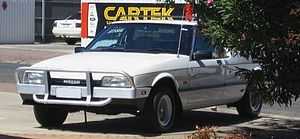Button car plan
| Original vehicle | Badge engineered derivative |
|---|---|
| Ford Falcon (utility) | Nissan Ute |
| Holden Commodore | Toyota Lexcen |
| Nissan Patrol | Ford Maverick |
| Nissan Pintara | Ford Corsair |
| Nissan Pulsar | Holden Astra |
| Toyota Camry | Holden Apollo |
| Toyota Corolla | Holden Nova |
The Button car plan, also known as the Button plan was the informal name given to the Motor Industry Development Plan, an Australian federal (Labor) government initiative intended to rationalise the Australian motor vehicle industry and transition it to lower levels of protection. It took its name from Senator John Button, the federal Minister for Commerce, Trade and Industry.
Industry consultation had begun in mid 1983 with the scheme announced in mid 1984 with a proposed start date of 1985 - after John Button visited Japan to inform the car companies there of the contents of the plan. At the time of its inception, Australia's motor industry was heavily protected by import tariffs, and quantitative restrictions on imports or quotas which protected the assembly of thirteen models by various manufacturers. The Button car plan aimed to reduce this number to six models, with the aim of forcing industry consolidation. The overarching aim of the scheme was to make the motor vehicle industry in Australia more efficient by consolidation of resources, allowing the import tariffs to be gradually reduced. This in turn would theoretically expose the local industry to increased competition from imported products, fostering improvement in local vehicles and creating the basis for a competitive export industry.
The most obvious effect of the plan for the Australian car buyer was the appearance of badge engineered vehicles, where the same basic vehicle was sold by several companies under different names. Other approaches included the Ford Courier and Mazda B-Series utilities utilising Mitsubishi's 2.6-litre Astron four-cylinder engine, and a proposal to replace Mitsubishi's locally built Colt with a rebadged Toyota Corolla. This proposal however, never eventuated.
Holden initially teamed up with Nissan in 1984, where the Nissan Pulsar was sold as the Holden Astra. Later Pulsar and Astra models in Australia used Holden-sourced powertrains. This arrangement dissolved in 1989, and General Motors–Holden's and Toyota formed United Australian Automobile Industries (UAAI). The vehicles produced as a result of this joint venture, the Holden Apollo (Toyota Camry), Holden Nova (Toyota Corolla) and Toyota Lexcen (Holden Commodore) lasted until 1996 for the Holden-badged derivatives models, and 1997 for Lexcen.[1]
This sharing of models proved unpopular with buyers, and original models outsold their badge engineered counterparts.[2] The last of such models, the Toyota Lexcen (Holden Commodore), was dropped in 1997. Rather than share locally assembled models with other manufacturers, Holden, Ford, and Toyota decided to import fully built-up models from subsidiaries elsewhere in the world, mainly Europe and Japan. Mitsubishi Motors did not share models with other manufacturers during the period of the plan and ended Australian manufacturing in 2008; Nissan ended car manufacturing in Australia completely in 1994.
-
_GL_sedan_02.jpg)
Ford Corsair (Nissan Pintara) from 1989.
-
_SLX_sedan_(2008-12-28)_01.jpg)
Holden Apollo (Toyota Camry) from 1989.
-

Holden Nova (Toyota Corolla) from 1994.
-
_CSi_sedan_01.jpg)
Toyota Lexcen (Holden VS Commodore) from 1995.
-

Nissan Ute (Ford XF Falcon) from 1989
See also
References
- ↑ http://www.manmonthly.com.au/news/the-big--boom-and-bust--era-of-australian-manufact
- ↑ "Union ... and demarcation". Fairfax Media. 2000-05-26. Retrieved 2008-03-10.